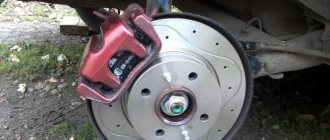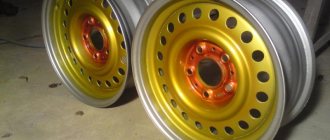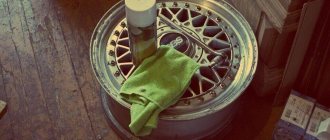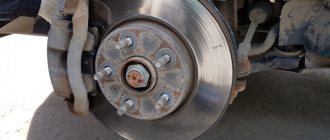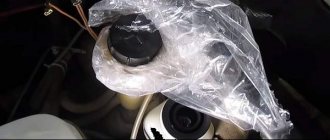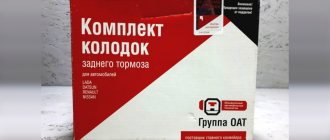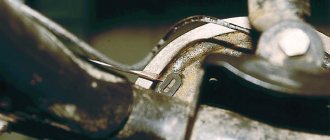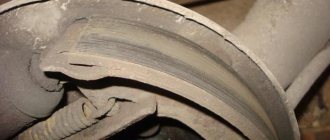Many car owners sooner or later think about turning brake discs, but most of them do not understand how it is done and whether it is justified at all. Let's figure it all out.
Constant trips by car force the driver to more closely monitor the condition of the “iron horse” and promptly respond to any malfunctions.
In particular, brake pads and discs, which are the “weakest link” of the braking system, require special care.
And if in the case of brake pads the best option is replacement, then the “life” of the brake discs can be extended by performing a number of measures.
All that is needed is timely grooving of the brake discs.
Why do they change or sharpen?
In fact, you can ride these too! BUT it’s not just that you come to the service center and complain that when you press the brake pedal you have:
- The steering wheel hits so hard you can't just hold it
- There is a very strong vibration in the body
- By the way, many people also experience extraneous sounds in the suspension
It is worth noting that they actually last about two to three times when changing the brake linings, and then they need to be changed.
The thing is that with high mileage, the pads fill grooves on the surface of the disc, the sides become non-parallel, and pits and protrusions form. An edge forms on the top of the disc.
Also, temperature changes when you abruptly drive into a puddle can really lead to it, that is, as our common drivers say, “carobit.”
And now, when you press the brake pedal, the pads are pressed against the disc under the influence of the caliper pistons, and all these irregularities are transmitted to the steering wheel or even the suspension and body.
Well, what remains is either to install completely new ones, or to sharpen these old ones, and not much, but to a small size (more on this a little later).
This is interesting: How to make the suspension softer?
Pros and cons of grooving
All shortcomings can be easily eliminated after turning the disc, but it is important to understand that this procedure cannot be carried out an infinite number of times. Sooner or later the disk will have to be replaced. At the moment when its thickness reaches the minimum specified for this type of car. This is the main disadvantage of the groove - the disc gradually becomes thinner, and this leads to its fragility.
The main advantage is the price. If you have to fork out 10-40 thousand rubles to replace a new disk, depending on the car model, then turning it will cost 4-5 times less.
About the price
As we have already talked to you, it costs VERY, VERY MUCH to install new ones! For example, for business class it generally costs from 25 to 40,000 for originals. How much will it cost to sharpen? I’ll answer right away - much cheaper, about 4 sometimes 5 times! And if you find a guy who does this for himself, as a “coven”, then you can generally do it for 1500 rubles per pair, this is what my friend did for a CAMRI
There are also two types of grooves:
- With removal, when the entire operation is carried out on the machine
- Without removal, when a special machine with two cutters is attached to the wheel hub and it sharpens the surfaces
If you contact a service station for a process with removal , then it turns out that the average prices are approximately the following:
- Car “A” and “B” class - approximately 3000 - 3500 rubles per pair
- “C” class – 3500 – 4000
- "D" about 5000 - 6000 rubles.
I don’t know about other classes; as a rule, executive cars are serviced with new spare parts.
If we take the process without removal , then the prices are slightly lower, by about 500 - 1000 rubles. It’s like what kind of service will bend you. Why is it cheaper, simply because there is no need to remove the disks and carry them somewhere, put them on machines and stuff the internal “mirror” or as they also call the plane. It’s trivial that all two planes are less of a hassle (I’ll explain a little later).
Pros and cons of grooving
We have already talked a lot about the advantages above, as it seems to me the main thing here is PRICE! Once again, the cost is 4–5 times cheaper than buying a new sample.
But there are also a lot of disadvantages here. Moreover, they do not relate to grooving methods, but rather to the greed of craftsmen or service stations.
Wheels for budget cars are made mainly from cast iron alloys. Of course, sports and expensive cars can have ceramic or even composite ones installed, but for the budget class this is rare.
There is such a thing as minimum thickness ; you should not violate it. These are different indicators for different types of cars. It is also worth distinguishing between ventilated and non-ventilated disk systems. For example, on our VAZ the minimum thickness (non-ventilated) is 10.8 mm, ventilated - 17.8 mm, if you take Renault or Nissan - 20 mm
WHAT HAPPENS IF YOU TURN MORE? This is where the main reason for disc failures (and the greed of the craftsmen) lies; if you remove more metal, then the blade itself becomes very fragile, it quickly heats up when braking, and if you get into a puddle due to temperature changes, there is a high chance that it will be much will drive faster. It can also simply split or break, which is already dangerous, because it turns out that at speed one wheel can suddenly lock. And here we are not far from a major accident. Masters who, although they want to make money from you, know this, but often turn a blind eye to it and sharpen it anyway, THIS IS WRONG. We must always remain human.
In general, if the thickness is critically minimal, for example, 150 - 200,000 kilometers have passed, then I strongly advise you not to sharpen them! As sad as it sounds, BUT HERE IS ONLY A REPLACEMENT.
Entry of dirt and foreign objects
Most often, a problem is signaled by extraneous noises that occur not only during braking, but also when the car is moving in various modes.
It can be either a quiet rustle or a grinding sound that hurts the ear.
When the first suspicions arise, it is worth inspecting the components of the brake system, clearing them of foreign objects and contaminants. In the case of disks, this usually requires blowing out the components with compressed air or removing the foreign object with a screwdriver.
It's more difficult with drums. They definitely have to be removed. If scratches and grooves are found on the metal surface, it means that discs or drums need to be resurfaced. The sooner you do this, the greater the chance of extending the life of the damaged part.
Souring or uneven operation of the cylinders
Souring of calipers and cylinders is a frequently occurring problem associated with damage to the protective boots or the fact that the car has not been used for a long time. In both cases, corrosive damage to the surface of the pistons occurs with the formation of a rather thick layer of oxides on them, which impedes the normal operation of the mechanism. The following steps must be taken:
- Restore the mobility of components by cleaning them from corrosion.
- Replace damaged boots and seals.
But if measures to eliminate the malfunction are taken late, the damage to the working surface of the disk or drum is great, and grooves cannot be avoided.
Grooving brake discs. Video:
Summarize
Sometimes there is no point in grooving. As noted above, today there are a huge number of Chinese brake discs. It is worth noting that not all of them are of poor quality. You can also pay attention to European analogues. Reasonable price tag and fairly good metal. Try not to brake at high speed in puddles, because overheating and sudden cooling often lead to bending of the brake disc.
Source fb.ru
AutoOt.ru » Car repair » Grinding brake discs with your own hands.
A popular procedure among many car enthusiasts, turning brake discs and drums is a good way to extend the life of critical parts.
Scratches and grooves formed on the working surface of the part affect the operation of the entire braking system. They arise for various reasons. Among the most likely:
- Dirt and foreign objects such as sand, small pebbles, glass shards or metal shavings get into the gap between the friction lining and the disc surface.
- Souring or uneven operation of the cylinders and calipers pressing on the pads.
- Distorted brake pads due to improper installation.
- Poor quality friction lining material.
- Overheating and disk deformation.
- Natural wear of metal due to friction.
- Late replacement of brake pads.
All this is not at all a reason to send expensive components for scrap. Many problems can be avoided if the necessary measures are taken in a timely manner. It is much wiser not to think about how to groove brake discs with your own hands, but to prevent the occurrence of a malfunction.
Withdrawal process
Here, on the one hand, everything is much easier, on the other, much more difficult. It’s easier because the disc can be completely removed, there is no need to hang the caliper and attach any parts to the suspension itself. What’s more difficult is that you need to grind not just one surface, but three at once! Moreover, it is worth doing without removing the disk, it is fixed once, and we go through all the surfaces at once. If you shoot, the parallelism of the planes will definitely be broken, so you will make things even worse.
REMEMBER!!! In the method of grooving with removal, you need to process three surfaces at once WITHOUT REMOVING FROM THE MACHINE - the top, bottom and near the hub, so that they are all perfectly parallel! Otherwise there will be beating.
The whole difficulty here is that the cutter on the outside is easy to find, but it is DIFFICULT to climb back without removing it. A certain “device” will be required, such as a reverse cutter or a special machine.
The disadvantage of this method is that many craftsmen make a groove by removing it and turning it on the other side, which actually makes it even worse.
Advantages and disadvantages
Not every motorist decides to grind them, preferring to simply replace slightly worn and deformed brake discs.
Everyone decides for themselves whether it is worth turning
It is important to understand that this cannot always be done
The advantages of grooves include the following points:
- savings on replacing brake discs;
- increasing the service life of the brake set.
As for the shortcomings, the following should be taken into account. This is not an endless procedure, which is carried out until a certain degree of disc wear. Not everyone is able to qualitatively turn a part with their own hands. And if you make a mistake, the brakes may even fail the next time you try to stop the car while driving.
That’s why motorists mostly sharpen their rims for reasons of economy. Not everyone is willing to pay 10-40 thousand rubles for new wheels, preferring to pay 1-4 thousand for sharpening. When processing independently, the price is completely formed from the purchase of necessary consumables. In some cases it's free.
When there is a need for grooving
Each car comes with documentation from the manufacturer, in which you can find recommendations for operation and repair. It also describes the technical and operational characteristics of various systems, including the brake system.
Before and after grooving
The average for modern cars is a mileage of up to 100 thousand km for brake discs and up to 30 thousand for pads. Mileage recommendations vary depending on the make, model, or year of the vehicle.
Also, the intensity of wear is influenced by individual driving style. Frequent braking or sharp braking at high speed results in greater wear and tear on the disc/pad pair.
Early wear of this unit can be detected by several signs:
- intense heating of the disks , which can be noticed after a relatively short run by touching any part of it;
- extraneous sounds occur (creaking, whistling, etc.) after pressing the pedal;
- the braking distance has increased and the efficiency of the system has decreased;
- during braking, the steering wheel vibrates , sometimes it is supplemented by a slight kickback in the pedal;
- inspection of the disc revealed obvious wear and corrosion elements with possible mechanical damage.
Any one of these reasons will be enough to look for a machine for turning brake discs without removal or with removal. However, if this operation has already been carried out repeatedly with this car, then it is necessary to control the thickness of the discs so as not to oversharpen them. The minimum size is specified by car manufacturers in the car's operating instructions.
This is interesting: Do-it-yourself repair and replacement of the camshaft when worn
Service life of brake system parts, disc grinding methods
Like all components and mechanisms in a car, parts of the brake system (TS) are subject to wear; they have a certain service life set by the manufacturer. On average, pads last from 20 to 50 thousand km, brake discs (BD), as a rule, last twice as long. But the resource may be different, it depends:
- on driving style;
- weather conditions;
- quality of materials;
- compliance with standards during repairs.
With frequent braking and sudden pressing of the brake pedal, parts wear out more intensely, heating causes deformation of the brake pedal, and because of this, the brake pads also work unevenly. Also, the service life of pads and discs is reduced when the car is used in wet weather; non-original spare parts of dubious manufacture do not last long.
It is advisable to replace TDs if their working surface is worn beyond the established norm, or the spare parts themselves are inexpensive. Of course, you can always buy new brake discs, but there is no absolute guarantee that the runout during braking will not disappear, since the parts are of different quality, or the cause of the defect may be hidden in something else (for example, dirt has accumulated between the disc and the hub, the hub itself deformed).
Known methods for grooving TD:
- on a lathe;
- in garage conditions on an emery machine;
- independently using an emery wheel directly on the car;
- using Pro Cut equipment.
The second and third methods do not guarantee good results, and are most often used in emergency cases, when you only need to drive for a while, then you will still need to carry out better repairs. Grooving on a lathe gives better results, but it does not take into account the fact that the defect may be hidden in other parts. Diagnostics and repair at the Pro Cat stand is the most reliable method of getting rid of vibrations in the brake system; the only disadvantage of such a solution is that the financial investment is not always justified. In car services, such work is not cheap, sometimes the cost of repairs exceeds the cost of the spare parts themselves.
Self-growing options
Since the price of professional grooving services scares many, some motorists are thinking about carrying out such a procedure on their own.
I strongly advise against taking on such work unless you have the skills, experience and special equipment. Such grinding will definitely not get rid of the disc runout, and will serve as a temporary measure. Often in video instructions, as well as in descriptions of self-growing published on the same Drive website, a grinder, grinding wheels, sandpaper and other available abrasives are used.
The effect is insignificant and only restores the surface of the brake disc for a while. Therefore, it is preferable to leave the unit in the hands of professionals. Car service centers have a special stand that allows you to process the product without removing it.
In this case, we can distinguish 2 methods that can still be used in garage conditions, trying to return the performance of the brake unit to its previous level with your own hands.
File or grinder
I’ll say right away that the presented method is only suitable for VAZ cars, domestic cars and old foreign cars. It’s interesting that AvtoVAZ even describes in its operating instructions how the car owner can remove the beads himself using a file.
There is an improved way to get rid of beads. The procedure looks like this:
- First, the car is raised and the necessary wheel is removed, behind which the problematic element is located;
- Then the car engine starts;
- 5th gear is engaged;
- To remove the bead, you can use a file or a coarse grinder disc;
- By applying a small force to the disk with a tool, a groove is made by rotating the wheel;
- After processing, the disc is degreased.
As you understand, an assistant is needed here so that one person sharpens the disk, and the second presses the gas pedal to ensure rotation of the wheel hub.
It is important to be extremely careful. Do not under any circumstances use this method on foreign cars, even if it is a used car, or on new cars.
Sanding without removal by machine
If you do the groove yourself, then only with this method. Since no one will buy expensive specialized equipment for their garage, most make do with a regular lathe.
But modern technologies make it possible to get a special machine for grooving for relatively little money. This is a high-level unit that can partially replace professional grooving machines.
Grooving using a special machine is performed without removing the disk itself. The device, equipped with an electric motor, is mounted on a disk, and there are cutters on both sides of the unit. Thus, it is possible to get rid of even beating in garage conditions. More details about using the machine should be read in the manual for the specific model.
First, the stand is set up and adapted to the disk parameters. Then, literally in 5 minutes, the device itself restores the element of the brake system, removing the necessary layer.
And since we’re talking about the braking system, it’s not a bad idea to understand the operation of the brake’s neighbor in the form of a clutch.
What do you think about do-it-yourself grooving? Is it worth doing it yourself, or is it better to take the discs to a car service center that has programmable, automated professional equipment?
Why is boring done?
You can call the procedure boring, grooving or grinding. This does not change the essence.
Such manipulations are considered a very effective method aimed at increasing the service life of the brake system element. At the same time, the level of safety during vehicle operation increases. After all, regardless of the speed and driving style, even the most careful and slow drivers' brakes are subject to gradual wear, wear, etc. As a result, grooves, irregularities and other unwanted deformations appear.
To get rid of them and return the disk to its previous efficiency, a groove is made. It is almost impossible to avoid sudden braking, exposure to moisture, overheating and corrosion.
It is a mistake to believe that infrequent use of the car extends the service life of the unit. On the contrary, the more the car costs, the faster rust forms, the brakes sour and become unusable.
If the brakes have wear, unevenness, grooves and roughness, this will negatively affect the disc mirror. Also, the production products begin to more actively destroy the element. Without servicing or changing the brakes, you run the risk of suddenly finding yourself without them. As a result, the car will not be able to brake. It’s hardly worth talking about the possible consequences of losing a brake unit.
Therefore, a special device is used, professional equipment and a homemade machine are used. Some sharpen discs using old pads, a grinder and simple abrasive discs. Others perform manipulations on a lathe, causing ripples.
Late replacement
When the linings are completely worn out, the friction that occurs between the metal surfaces of the pads and the surfaces of the discs or drums quickly destroys the parts. Some cars are equipped with special wear sensors. If they are not there, you should regularly check the brake system yourself.
Not an easy task
For obvious reasons, many car owners are interested in how to sharpen a brake disc with their own hands. At the risk of disappointing them, we will try to answer honestly. It is impossible to carry out such work without special equipment and certain skills.
You should not try to process the surface of a part whose dimensions must be maintained to within hundredths of a millimeter using sandpaper, much less a file. There are only two options:
- Turn the brake discs on a regular lathe.
- Use special equipment designed to perform this type of work.
Any other processing methods will not give the desired result.
Equipment layout
This type of equipment is used to equip specialized car services and service stations. Grooving brake discs is a procedure for removing excess steel to return the part to its original configuration.
Structurally, the machine consists of a processing unit, which includes a power unit and a head with cutters. The latter has the function of displacement relative to the brake disc mounted on the pin. To set the optimal processing mode, the rotation speed of the spindle head can be changed. To increase mobility, many machine models have a movable frame. This makes it possible to process wheels without removing them from the car.
The processing process consists of the following steps.
- Determining the degree of wear of the brake disc. At this stage, it becomes clear whether it is possible to restore the original qualities of the braking system. It is important that the updated brake disc does not negatively affect the safety of the car.
- Setting equipment parameters. In this case, the outer diameter and its mounting dimensions are taken into account. The choice of cutter model depends on the degree of processing.
- Performing a groove. At this stage, it is necessary to control the thickness of the material removed.
- Checking dimensions.
During the grooving process, the surface of the disc may heat up. In this case, it is necessary to use coolant. The optimal system option is to supply coolant through the tool (cutter).
If a machine is used for turning brake discs without removing them from the car, it is important to choose the correct positioning of the processing tool. To do this, the equipment must have local lighting. Measuring tools must be used to control current dimensions.
Grooving on a lathe
Not everyone can use such equipment. A lathe, which has the necessary accuracy and has dimensions that allow it to process large-diameter parts, sometimes costs more than a car. There is no point in buying it to periodically solve a narrow range of problems.
But even if you have access to equipment with the necessary parameters and you have the appropriate skills, turning brake discs or drums without making special equipment will be impossible.
The fact is that it is impossible to install the part on the machine with the required accuracy simply by spreading the chuck jaws in the central mounting hole. We will have to act differently. Have to:
- Make a special mandrel that matches the shape and size of the wheel hub and has a shank that can be clamped in the chuck. The accuracy of the radial and axial runout of the mandrel should be no more than 0.03 mm.
- Attach the disk or drum to the mandrel (for this you can use the standard fastening system), and then install the mandrel itself into the cartridge.
- Having installed a cutter of a suitable size, groove the working surface of the disk or drum. Runout parameters should not exceed 0.05 mm with surface roughness Rz
In the case of drums, this approach is quite justified. But if we are talking about turning brake discs, then a lathe is not the best way to solve the problem. Fortunately, there are other methods.
Comments • 24
But a drawing is possible. Thank you
0.07 is out of tolerance. Tolerance 0.05
See further continuation about this machine. And write comments to me; your opinion as a specialist is very important.
Thanks a lot! Very good device! I will make it as soon as possible!)))) Good luck to you!
Super. I also want to build one))
You had a great idea. We also sharpened the discs on our fielder clip-share.net/video/RkFidW91_dI/video.html
I watched your video on grooving with an angle grinder. Well, let's say knock down the collar. Judging by the appearance, the output is very large. Can these discs be replaced? Take care of yourself and don't forget about other road users. Good luck on the roads!
Start making and selling
As soon as our carriers are completely closed down, I will open production. Having already watched this video, my acquaintances and friends came to see me.
There is also a schoolboy. I'm waiting for a video about the adaptation for it under the disks.
@AvtoBro didn’t know I recently signed up for this and was waiting for it.
clip-share.net/video/zSyG9fjBOIA/video.html here it is. the video came out a long time ago
The cost of turning a disc is 200 rubles. Removes 3 surfaces per installation. There must be absolute rigidity to cut off scorch marks. This also ensures the straightness of the surfaces. I’ll adapt it to the firebox, buy yourself a turning machine 1k62
@Turning Workshop DU, auto repair completely agree.
@man 1377 No one has handled cargo trucks before me, but passenger cars sometimes do, and I consider it a complete freebie. I inserted the disk, set the passage and go smoke, drink coffee to the pleasant rustle of cutting cast iron.
or better yet 1k625 and sharpen drums for trucks, churgyk, churgyk earned twenty rubles.
@AvtoBro sold it in vain, it’s better to find a place to put it. It's everyone's business, of course...
I sold 16k20 Yerevan only because I have nowhere to put it and I have no use for it.
If you do this so that you drag the landing pad under the wheel where the studs are, it will generally be very correct. Well done. And what did he give to his neighbor?
Watch the continuation of this video clip-share.net/video/ZMTuVnN_gI4/video.html
The process itself is normal, but prolonged rotation of one wheel while the other is standing on the drive axle is damaging to the gears and the differential axle, since this unit is not designed for prolonged rotation and high speeds.
if the load is not calculated . and hanging around in the air even without a wheel is really nothing.
Can I buy a machine from you? Are you selling ready-made?
No, I'm not selling. Soon I’ll take a picture of how it works in more detail and how to make it yourself, maybe it will help you. :)
Good afternoon. Is it possible to make something similar to order?
@Evgeny Prokudin Here's everything for you as you wanted clip-share.net/video/ZMTuVnN_gI4/video.html.
I'll probably make a full-length video. On May 10 alone, 8 people asked for drawings and advice on how to make it. I'll try
